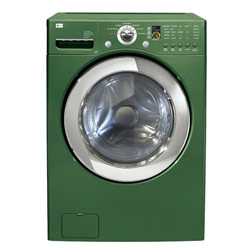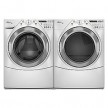Mildew and Mold Smell – Front Load Washing Machines
Removing Mildew & Mold Smell from Front Loader Washers
 Recently we started noticing a mildew / mold smell in our laundry room. It didn’t take long for me to realize that our new (6 months ago) Kenmore Elite Front Load Washing Machine was the cause of the problem.
Recently we started noticing a mildew / mold smell in our laundry room. It didn’t take long for me to realize that our new (6 months ago) Kenmore Elite Front Load Washing Machine was the cause of the problem.
After doing some quick research we quickly realized that the benefits of front loading washers come at a price and that’s a potential mold and mildew problem. There’s a significant design difference between the old conventional top loading washers and the new front loaders. That difference is in the door, the older top loaders have a metal door that’s closes but not tightly, while the new front loaders seal to an air and water tight seal.
The fact that front loading washers have a door that seals tightly against air and water is a huge problem when you think about mold and mildew. Closing a sealed door to a machine that’s damp and wet, especially in the warmer summer months, creates an environment ripe for mold and mildew to grow.
How To Prevent Mold & Mildew Smells In Front Loading Washers
After lots of research and discussions with quite a few front load washer owners it’s obvious that steps must be taken to prevent the growth of mold and mildew. If you own a front-loading washing machine then you should take the following steps on a regular basis.
- Wipe Down Door and Gasket – After using your washing machine it’s important to use a clean towel to wipe off the inside of the washers door and heavy rubber door gasket. This is one of the primary areas for mold and mildew to start growing. This task can be done after the last load of wash before the machine is to sit for more than a few hours.
- Leave Door Open – One of the best ways to stop mold and mildew from growing is by leaving the washer’s door slightly open between washes. This allows air to enter the washer and help dry out the drum and internal parts.
- Use Correct Amount Of Soap – Another common problem is using too much soap. Front-loading washers require far less soap than their older top loading relatives. Excess soap can also lead to mold and mildew problems.
How To Remove Mold & Mildew Smell from Front-Loading Washing Machines
If your washer already smells like mold and mildew then it’s time to do some cleaning! We recently cleaned ours by first hand cleaning the rubber gasket with mold detergent. Next we ran the washing machine on a special “Clean Washer” cycle. The washer’s operating manual suggests running that cycle with “bleach only”.
If that approach doesn’t work you may need to have an appliance repair person come to your home. They may need to take apart the washer and clean some of the areas behind the drum where mold and mildew may have accumulated. If you’re comfortable with this type of task you may be able to do it yourself. However, special care should be taken to prevent both injury to yourself and damage to the washer.
There are lots of products on the market now being sold to help with the problem. Some of them include:
- Smelly Washer
- Norwex Laundry Detergent
- Zep Odor Control Concentrate – Sold at The Home Depot
If you have any tips on this problem we’d love to have you share them in the comments below.














We recently purchased a front loader from a friend. He warned us about this problem and we’ve been careful to leave the door open. He also gave us some Affresh washer cleaner tablets. They seem to do the trick.
Ethan – Thanks for the tip….any idea where you buy those?
I think Lowes but here’s their Where to Buy page.
For the real story on washing machine odor cures:
http://www.youtube.com/watch?v=Ua6OJPn0-fU
After your washer has been cleaned you’ll need to change your washing habits. Leaving the door opens actually worsens the problem because it dries out the odor-causing residue and makes it more difficult to clean. If your washer smells with the door open or closed it’s time to clean it!
Bad smells and spider corrosion in front load washing machines.
When all other remedies for curing bad smells coming from front load washers have been tried and have not been found satisfactory I believe the source of the smell may well be corrosion of the aluminium spider with the products of this corrosion harbouring ‘water’ that turns foul as described below, or, should no corrosion have occurred any retained water will, if left long enough, turn foul.
Aluminium, and its alloys, are corroded when immersed in an aqueous solution with a pH value below about 4.0 (acidic) [nitric acid is a well known exception] or above about 8.0 (alkaline), most laundry aids, detergent including HE detergent, borax, bleach (sodium hypochlorite), sodium carbonate (washing soda), sodium percarbobante (found in Affresh and OxiClean), sodium hydroxide, Affresh and OxiClean can have pH values above 8.0 should the required concentrations be reached. At the normal operating levels found in washing machines these values are not exceeded. However when the machine is shut down any water remaining will contain, inter alia, soil from the laundry, products of the interactions between the soil and the laundry aids used, unused laundry aids, and the chemicals found in the tap water. As the water from this mixture evaporates the concentration of the ‘impurities’ rises until such time as a ‘smelly sludge’ develops and/or a pH level above about 8.0 is reached and corrosion occurs.
Prime areas for these deposits to occur are, in my opinion, the recesses found at, or very near, the hub of some of the aluminium alloys spiders found in front load washing machines. The final spin, no matter how fast, will not, in my opinion, remove all the ‘water’ from theses recesses.
To view a corroded spider (not to the point of catastrophic failure) and one with a build of ‘smelly crud’ please visit: –
http://www.ripoffreport.com/appliances/electrolux-home-prod/electrolux-home-products-n-am-4cd6d.htm
These spiders were removed from Frigidaire built ‘Kenmore’ machines.
To see fractured spiders from Frigidaire built machines, Whirlpool ‘Duets’ and other manufacturers’ please visit: –
http://fixitnow.com/wp/2009/10/28/front-loading-washer-corrosion-contagion-a-menagerie-of-metallic-misery/
Or, for a Whirlpool spider
http://www.mysears.com/aboutme/jpm0940
Not all manufacturers use spiders with recesses, Speed Queen do not (Speed Queen call them trunnions) and photographs at: –
http://www.automaticwasher.org/cgi-bin/TD/TD-VIEWTHREAD.cgi?30834
show Miele spiderss without recesses. There may be others.
Unfortunately the only way to cure the bad smell and/or corrosion in these cases is to strip the machine down, clean it, perhaps modify the spider, reassemble and alter your laundry practices. Not a popular solution I would guess!
Since my last post it has come to my recent attention that there are two websites which details class action suites against Whirlpool because of smells from front loaders.
The first, http://www.whirlpoolclassaction.ca/ is in Canada, and the second, http://www.lieffcabraser.com/cases.php?CaseID=126 is in the USA.
Regards
We were having this problem with our lg washer. Then we read our owners manual(almost killed my husband) and realized there was a filter in the front in a little door. We cleaned out this filter and no more odor. You should also clean out the gaskets.
I worked as an appliance repair technician and ran across this complaint constantly about front load washing machines. This is my second idea submission and I’m trying to get a little help getting it off the ground. So, please check out my much needed product and leave me some feed back.
Thanks!
http://www.quirky.com/ideations/158694
FINALLY – A FIX~ My Whirlpool Duet washer is 2-1/2 yrs. old. (Out of warranty) I got the black grunge of black mold around the gasket. I cleaned best I could with Cascade Complete run through a cycle which helped + lots of vinegar. Still the gasket was left with some of the black mold.
I only use 1-2 T. of liquid HE detergent and 1/2 cup of white vinegar as my rinse. (no softeners).
Today my washer had tons of mold so I tried it again. This time what really worked was the BLEACH with a little Oxy added. I literally filled the dispenser with as much bleach as I could. A lot!
Then I ran the WHITE ONLY cycle on very HOT cycle. That did it! There is narry a black spot of mold on my machine. Whew!
This is so aggravating but there is nothing we consumers can do about this manufacturing flaw. There is a filter to be cleaned but we have no access door on our model to do it. The following year the manufacturer put a little door that opens, but for us, we have to dismantle the lower part of washer to get in there. A pain – not easy to do often.
TRY BLEACH – it really does work and I believe the Oxy is another aid which provides oxygen. Who knows what the drum looks like, however. Just hope for the best.
I had lived in an RV for 10 years with a European/Italian Splendid front loader and I never ever had black mold problems and I can’t figure out how these US washers are being made to cause this
mold. (???) The Italians have the market on quality front loaders, I think. Hope this tip helps you all… GOOD LUCK
We got rid of our front loaders 6 months ago because nothing that we tried worked… and we tried EVERYTHING! We then decided to get the top loaders without the agitator–problem solved!